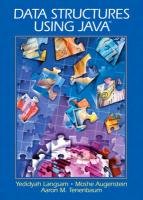
Synopsis
This book employs an object-oriented approach to teaching data structures using Java. Many worked examples and approximately 300 additional examples make this book easily accessible to the reader. Most of the concepts in the book are illustrated by several examples, allowing readers to visualize the processes being taught. Introduces abstract concepts, shows how those concepts are useful in problem solving, and then shows the abstractions can be made concrete by using a programming language. Equal emphasis is placed on both the abstract and the concrete versions of a concept, so that the reader learns about the concept itself, its implementation, and its application. For anyone with an interest in learning more about data structures.
"synopsis" may belong to another edition of this title.
From the Back Cover
Data Structures Using Java is an introduction to data structure abstraction. It provides information on abstract concepts and shows students how those concepts are useful in problem solving. It goes on to demonstrate that abstractions can be made concrete by using Java.
Java is an appropriate language to use in teaching the concepts of data abstraction since it contains the control structures necessary to make programs readable and allows basic data structures such as stacks, linked lists and trees to be implemented in a variety of ways.
Data Structures Using Java guides the reader through the steps of how to identify a problem, implement a solution, and apply the solution to a real-world situation. This book is also a valuable reference for professional programmers.
Key Features:
- Algorithms are explained in detail and analyzed showing step-by-step solutions to real-world problems.
- Issues and pitfalls that may occur as algorithms are transformed into programs are discussed.
- Each data structure is implemented in a variety of ways that demonstrate the real choices and trade-offs programmers face.
- Concepts in the text are illustrated by several examples (such as postfix notation, multiword arithmetic, etc.).
- Additional supplementary materials are available to the instructor. These include chapter objectives, PowerPoint slides of most of the figures in the text, solutions (and, when applicable, working code) to the end-of-chapter exercises, and working versions of all the code in the text.
"About this title" may belong to another edition of this title.
Other Popular Editions of the Same Title
Search results for Data Structures Using Java
Data Structures Using Java
Seller: ThriftBooks-Atlanta, AUSTELL, GA, U.S.A.
Paperback. Condition: Very Good. No Jacket. May have limited writing in cover pages. Pages are unmarked. ~ ThriftBooks: Read More, Spend Less. Seller Inventory # G0130477214I4N00
Data Structures Using Java
Seller: ThriftBooks-Atlanta, AUSTELL, GA, U.S.A.
Paperback. Condition: Good. No Jacket. Former library book; Pages can have notes/highlighting. Spine may show signs of wear. ~ ThriftBooks: Read More, Spend Less. Seller Inventory # G0130477214I3N10
Data Structures Using Java
Seller: Bay State Book Company, North Smithfield, RI, U.S.A.
Condition: good. The book is in good condition with all pages and cover intact, including the dust jacket if originally issued. The spine may show light wear. Pages may contain some notes or highlighting, and there might be a "From the library of" label. Boxed set packaging, shrink wrap, or included media like CDs may be missing. Seller Inventory # BSM.TK3Q
Data Structures Using Java
Seller: World of Books (was SecondSale), Montgomery, IL, U.S.A.
Condition: Good. Item in good condition. Textbooks may not include supplemental items i.e. CDs, access codes etc. Seller Inventory # 00093006929
Data Structures Using Java
Seller: Better World Books Ltd, Dunfermline, United Kingdom
Condition: Very Good. 1st. Ships from the UK. Former library book; may include library markings. Used book that is in excellent condition. May show signs of wear or have minor defects. Seller Inventory # 15367181-20
Buy Used
Ships from United Kingdom to U.S.A.
Quantity: 1 available
Data Structures Using Java
Seller: Phatpocket Limited, Waltham Abbey, HERTS, United Kingdom
Condition: Good. Your purchase helps support Sri Lankan Children's Charity 'The Rainbow Centre'. Ex-library, so some stamps and wear, but in good overall condition. Our donations to The Rainbow Centre have helped provide an education and a safe haven to hundreds of children who live in appalling conditions. Seller Inventory # Z1-C-082-04244
Buy Used
Ships from United Kingdom to U.S.A.
Quantity: 2 available
Data Structures Using Java
Seller: Toscana Books, AUSTIN, TX, U.S.A.
Paperback. Condition: new. Excellent Condition.Excels in customer satisfaction, prompt replies, and quality checks. Seller Inventory # Scanned0130477214
Data Structures Using Java
Seller: BennettBooksLtd, San Diego, NV, U.S.A.
paperback. Condition: New. In shrink wrap. Looks like an interesting title! Seller Inventory # Q-0130477214

